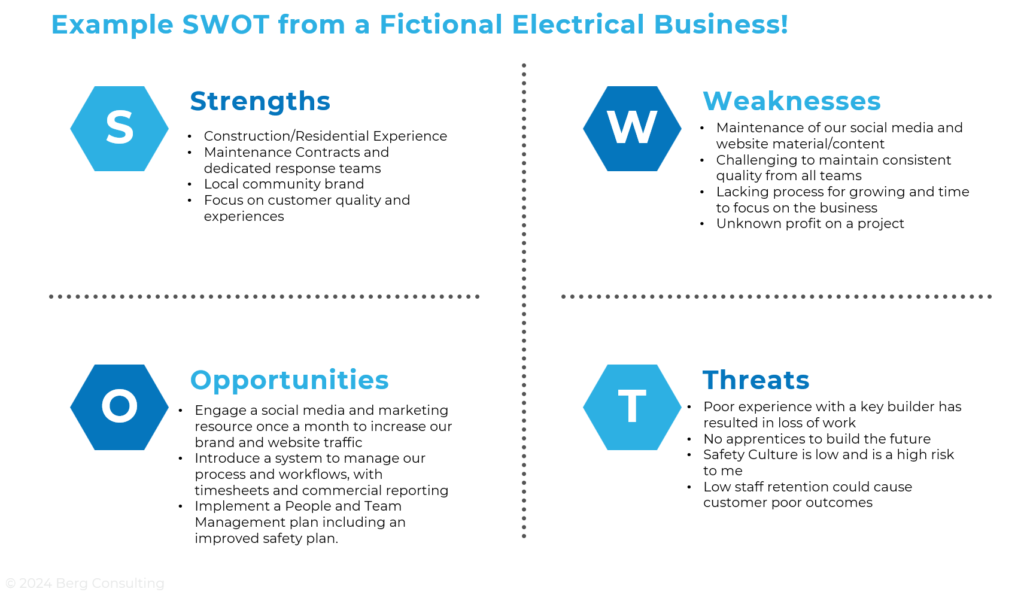A tradie’s guide to a SWOT Analysis:
Why You Need a SWOT Analysis in Your Business

Running a small trade or construction business isn’t just about getting jobs done—it’s about providing customers value beyond today. Every successful business does two things:
- Provides value to customers today. Delivering quality work, on time, with excellent service.
- Innovates for tomorrow. Staying ahead of competitors, embracing change, and ensuring you can keep providing value long-term.
As an example, safety. As a business owner, you’re not just responsible for delivering great work—you also have an obligation to keep your team, clients, and yourself safe.
In the trades and construction industry, safety is no joke. Neglecting safety can lead to injuries, loss of time, massive fines, or even jail time if something goes wrong. A SWOT Analysis helps you identify and mitigate risks so you’re not just hoping for the best—you’re prepared.
Think of a SWOT as your business strategy toolbox, helping you:
- Focus on what’s working
- Work on what’s not
- Stay ahead of risks, both financial and physical
What Is a SWOT Analysis?
A SWOT Analysis is a tool to assess your Strengths, Weaknesses, Opportunities, and Threats.
- Strengths: What are you doing well? Maybe it’s your reputation, your loyal clients, or your quality workmanship.
- Weaknesses: What are things you don’t do well or get negative feedback on? Could be slow invoicing, lack of tools, or not enough help on the tools.
- Opportunities: What are things your business can jump on for improvements? A big project, new partnerships, or upskilling your team.
- Threats: What’s a potential issue? Think competition, rising costs, or safety risks.
It’s about being honest and upfront with yourself and putting everything on the table so you can see the full picture.

How to Perform a SWOT Analysis
- Put some time aside
Block out an hour or so with your team or your partner/friend who knows your business. If it’s just you, no worries—you can do this solo. - Use our template
Download our free SWOT guide with instructions. Print or mark up on your computer or simply write it up on a whiteboard, with one box for each of the SWOT categories. - Workshop Each Category
Write down everything that comes to mind for each box. Be honest and specific:- Strength: “We’ve got 5-star reviews on Google.”
- Weakness: “I never follow up quotes.”
- Opportunity: “A new housing estate is being built nearby.”
- Threat: “That big-name competitor just moved into town.”
- Prioritise and Plan
Once the SWOT is filled out, prioritise by numbering them from a 1-5 (1 being highest priority), select the highest priorities to focus on. Then create a plan.- Turn Strengths into even bigger wins.
- Fix Weaknesses to improve.
- Jump on Opportunities for growth.
- Prepare for Threats so they don’t damage your business
- Follow Through
A SWOT is only as good as the action you take. Use the SMART goals to set tasks, timelines, and check back in to see how you’re tracking. What are SMART goals? Check out how SMART goals can help you apply improvements in an effective practical way.
Summary
A SWOT Analysis isn’t just some fancy corporate tool—it’s a practical way to focus your energy and make smart decisions. For tradies, it’s an opportunity to figure out what’s a roadblock, identify risks, and plan these opportunities to improve and grow your business.
Remember, you don’t have to analyse everything at once. Use a SWOT Analysis for a single purpose, like assessing your safety practices, improving customer service, or tackling a specific project. By focusing on one area, you can create targeted strategies and see results faster.
Ready to Get Started?
- Download My Free Tool:
- Visit My Website: Learn more about how we help tradies discover their hidden potential at www.bergconsulting.services.





